BUSM4589 - Analyzing Deming's Observations on Performance Management
VerifiedAdded on 2023/06/03
|11
|2825
|107
Essay
AI Summary
This essay critically reflects on W. Edwards Deming's observations regarding performance management, particularly the adverse effects he highlighted, such as the undermining of long-term planning, fostering fear, and demolishing teamwork. It explores the extent to which Deming's assertions remain relevant in contemporary organizations and examines how modern HRM practices attempt to address these issues. The essay analyzes relevant academic literature to support arguments, discussing the importance of organizational commitment, training and development, and employee involvement in decision-making. Furthermore, it emphasizes the role of skilled HRM practices, including rewards and recognition, training, and appraisals, in mitigating the negative outcomes associated with traditional performance management systems, promoting employee motivation, and fostering a positive organizational culture.
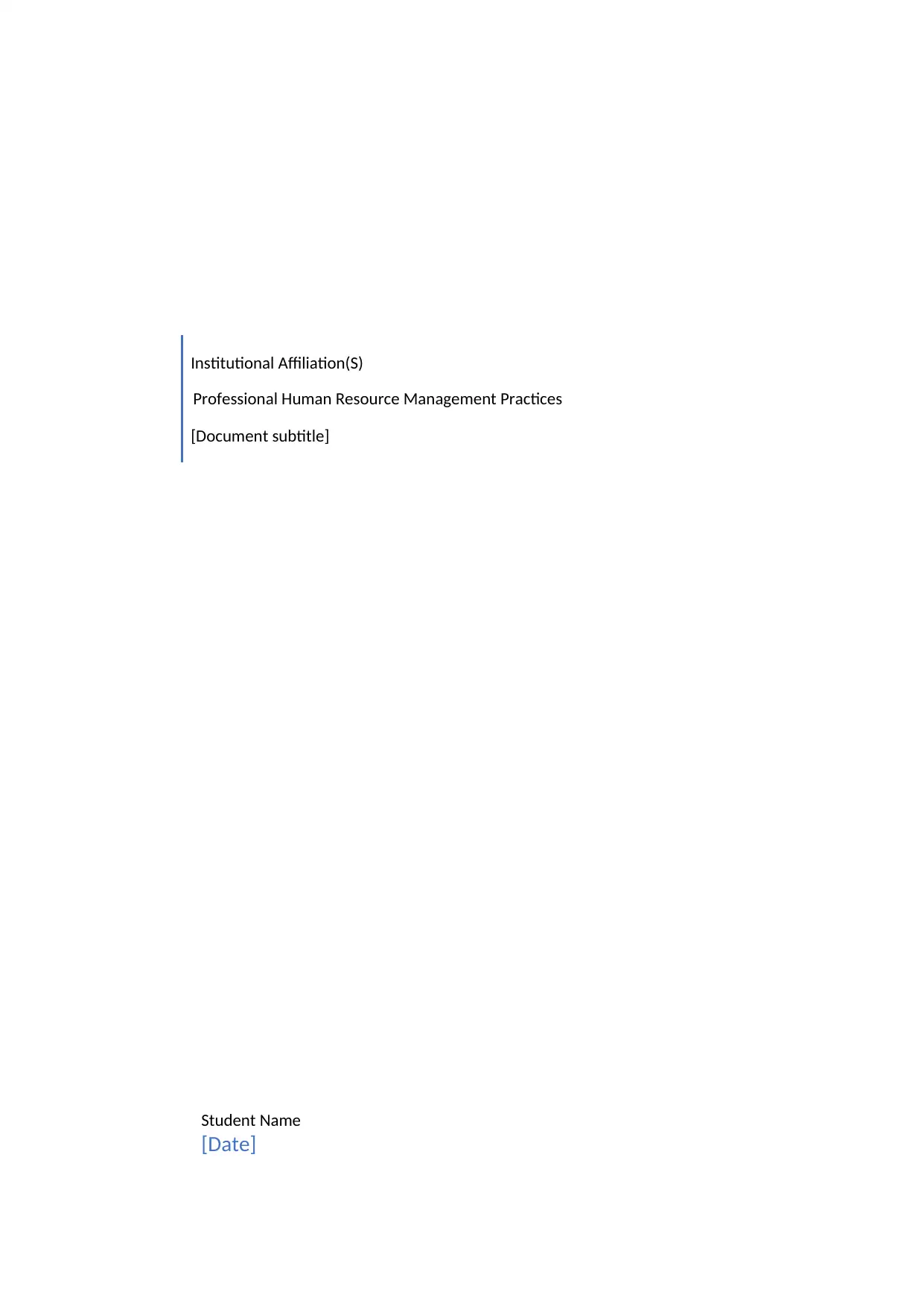
Institutional Affiliation(S)
Professional Human Resource Management Practices
[Document subtitle]
Student Name
[Date]
Professional Human Resource Management Practices
[Document subtitle]
Student Name
[Date]
Paraphrase This Document
Need a fresh take? Get an instant paraphrase of this document with our AI Paraphraser
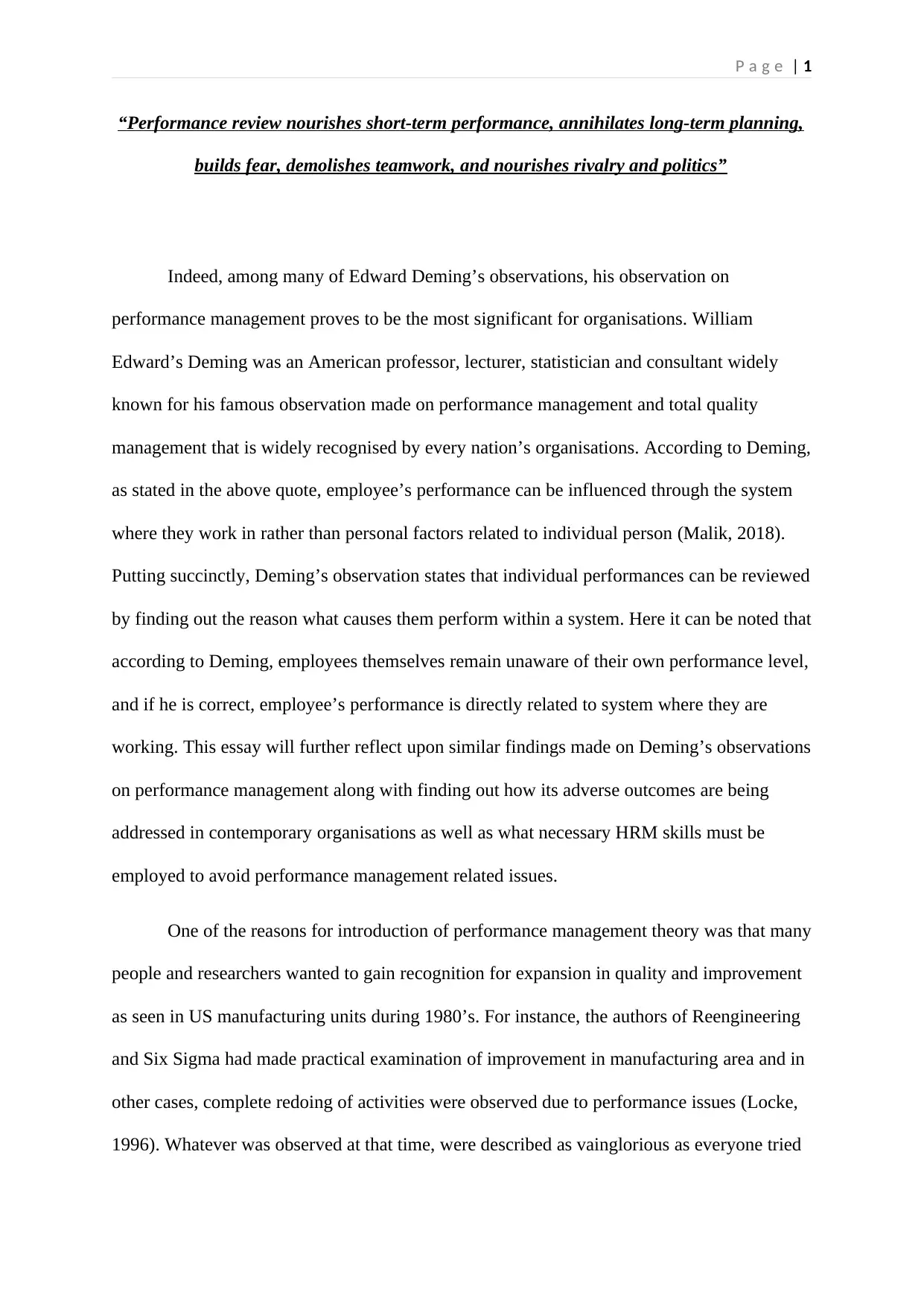
P a g e | 1
“Performance review nourishes short-term performance, annihilates long-term planning,
builds fear, demolishes teamwork, and nourishes rivalry and politics”
Indeed, among many of Edward Deming’s observations, his observation on
performance management proves to be the most significant for organisations. William
Edward’s Deming was an American professor, lecturer, statistician and consultant widely
known for his famous observation made on performance management and total quality
management that is widely recognised by every nation’s organisations. According to Deming,
as stated in the above quote, employee’s performance can be influenced through the system
where they work in rather than personal factors related to individual person (Malik, 2018).
Putting succinctly, Deming’s observation states that individual performances can be reviewed
by finding out the reason what causes them perform within a system. Here it can be noted that
according to Deming, employees themselves remain unaware of their own performance level,
and if he is correct, employee’s performance is directly related to system where they are
working. This essay will further reflect upon similar findings made on Deming’s observations
on performance management along with finding out how its adverse outcomes are being
addressed in contemporary organisations as well as what necessary HRM skills must be
employed to avoid performance management related issues.
One of the reasons for introduction of performance management theory was that many
people and researchers wanted to gain recognition for expansion in quality and improvement
as seen in US manufacturing units during 1980’s. For instance, the authors of Reengineering
and Six Sigma had made practical examination of improvement in manufacturing area and in
other cases, complete redoing of activities were observed due to performance issues (Locke,
1996). Whatever was observed at that time, were described as vainglorious as everyone tried
“Performance review nourishes short-term performance, annihilates long-term planning,
builds fear, demolishes teamwork, and nourishes rivalry and politics”
Indeed, among many of Edward Deming’s observations, his observation on
performance management proves to be the most significant for organisations. William
Edward’s Deming was an American professor, lecturer, statistician and consultant widely
known for his famous observation made on performance management and total quality
management that is widely recognised by every nation’s organisations. According to Deming,
as stated in the above quote, employee’s performance can be influenced through the system
where they work in rather than personal factors related to individual person (Malik, 2018).
Putting succinctly, Deming’s observation states that individual performances can be reviewed
by finding out the reason what causes them perform within a system. Here it can be noted that
according to Deming, employees themselves remain unaware of their own performance level,
and if he is correct, employee’s performance is directly related to system where they are
working. This essay will further reflect upon similar findings made on Deming’s observations
on performance management along with finding out how its adverse outcomes are being
addressed in contemporary organisations as well as what necessary HRM skills must be
employed to avoid performance management related issues.
One of the reasons for introduction of performance management theory was that many
people and researchers wanted to gain recognition for expansion in quality and improvement
as seen in US manufacturing units during 1980’s. For instance, the authors of Reengineering
and Six Sigma had made practical examination of improvement in manufacturing area and in
other cases, complete redoing of activities were observed due to performance issues (Locke,
1996). Whatever was observed at that time, were described as vainglorious as everyone tried
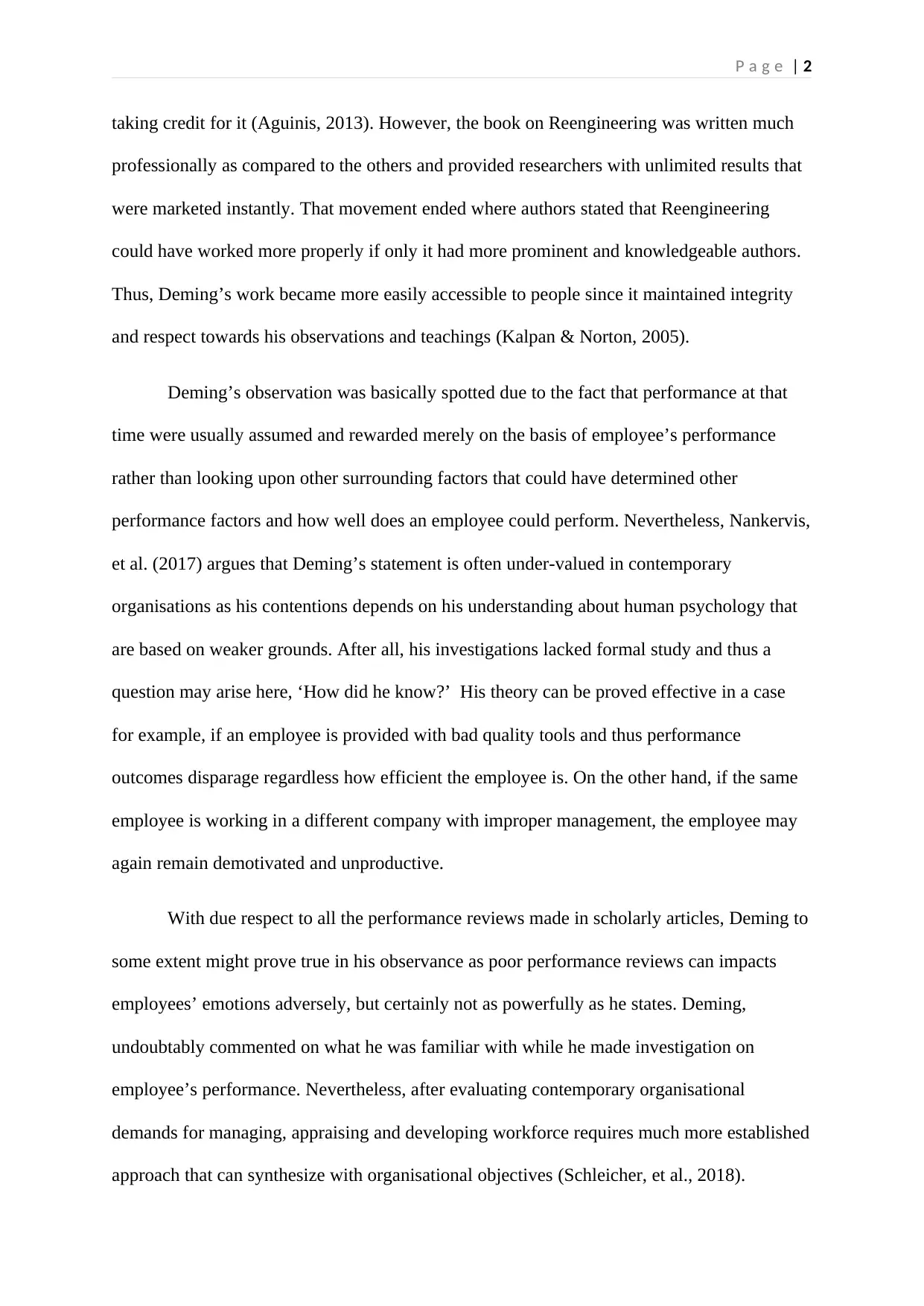
P a g e | 2
taking credit for it (Aguinis, 2013). However, the book on Reengineering was written much
professionally as compared to the others and provided researchers with unlimited results that
were marketed instantly. That movement ended where authors stated that Reengineering
could have worked more properly if only it had more prominent and knowledgeable authors.
Thus, Deming’s work became more easily accessible to people since it maintained integrity
and respect towards his observations and teachings (Kalpan & Norton, 2005).
Deming’s observation was basically spotted due to the fact that performance at that
time were usually assumed and rewarded merely on the basis of employee’s performance
rather than looking upon other surrounding factors that could have determined other
performance factors and how well does an employee could perform. Nevertheless, Nankervis,
et al. (2017) argues that Deming’s statement is often under-valued in contemporary
organisations as his contentions depends on his understanding about human psychology that
are based on weaker grounds. After all, his investigations lacked formal study and thus a
question may arise here, ‘How did he know?’ His theory can be proved effective in a case
for example, if an employee is provided with bad quality tools and thus performance
outcomes disparage regardless how efficient the employee is. On the other hand, if the same
employee is working in a different company with improper management, the employee may
again remain demotivated and unproductive.
With due respect to all the performance reviews made in scholarly articles, Deming to
some extent might prove true in his observance as poor performance reviews can impacts
employees’ emotions adversely, but certainly not as powerfully as he states. Deming,
undoubtably commented on what he was familiar with while he made investigation on
employee’s performance. Nevertheless, after evaluating contemporary organisational
demands for managing, appraising and developing workforce requires much more established
approach that can synthesize with organisational objectives (Schleicher, et al., 2018).
taking credit for it (Aguinis, 2013). However, the book on Reengineering was written much
professionally as compared to the others and provided researchers with unlimited results that
were marketed instantly. That movement ended where authors stated that Reengineering
could have worked more properly if only it had more prominent and knowledgeable authors.
Thus, Deming’s work became more easily accessible to people since it maintained integrity
and respect towards his observations and teachings (Kalpan & Norton, 2005).
Deming’s observation was basically spotted due to the fact that performance at that
time were usually assumed and rewarded merely on the basis of employee’s performance
rather than looking upon other surrounding factors that could have determined other
performance factors and how well does an employee could perform. Nevertheless, Nankervis,
et al. (2017) argues that Deming’s statement is often under-valued in contemporary
organisations as his contentions depends on his understanding about human psychology that
are based on weaker grounds. After all, his investigations lacked formal study and thus a
question may arise here, ‘How did he know?’ His theory can be proved effective in a case
for example, if an employee is provided with bad quality tools and thus performance
outcomes disparage regardless how efficient the employee is. On the other hand, if the same
employee is working in a different company with improper management, the employee may
again remain demotivated and unproductive.
With due respect to all the performance reviews made in scholarly articles, Deming to
some extent might prove true in his observance as poor performance reviews can impacts
employees’ emotions adversely, but certainly not as powerfully as he states. Deming,
undoubtably commented on what he was familiar with while he made investigation on
employee’s performance. Nevertheless, after evaluating contemporary organisational
demands for managing, appraising and developing workforce requires much more established
approach that can synthesize with organisational objectives (Schleicher, et al., 2018).
⊘ This is a preview!⊘
Do you want full access?
Subscribe today to unlock all pages.

Trusted by 1+ million students worldwide
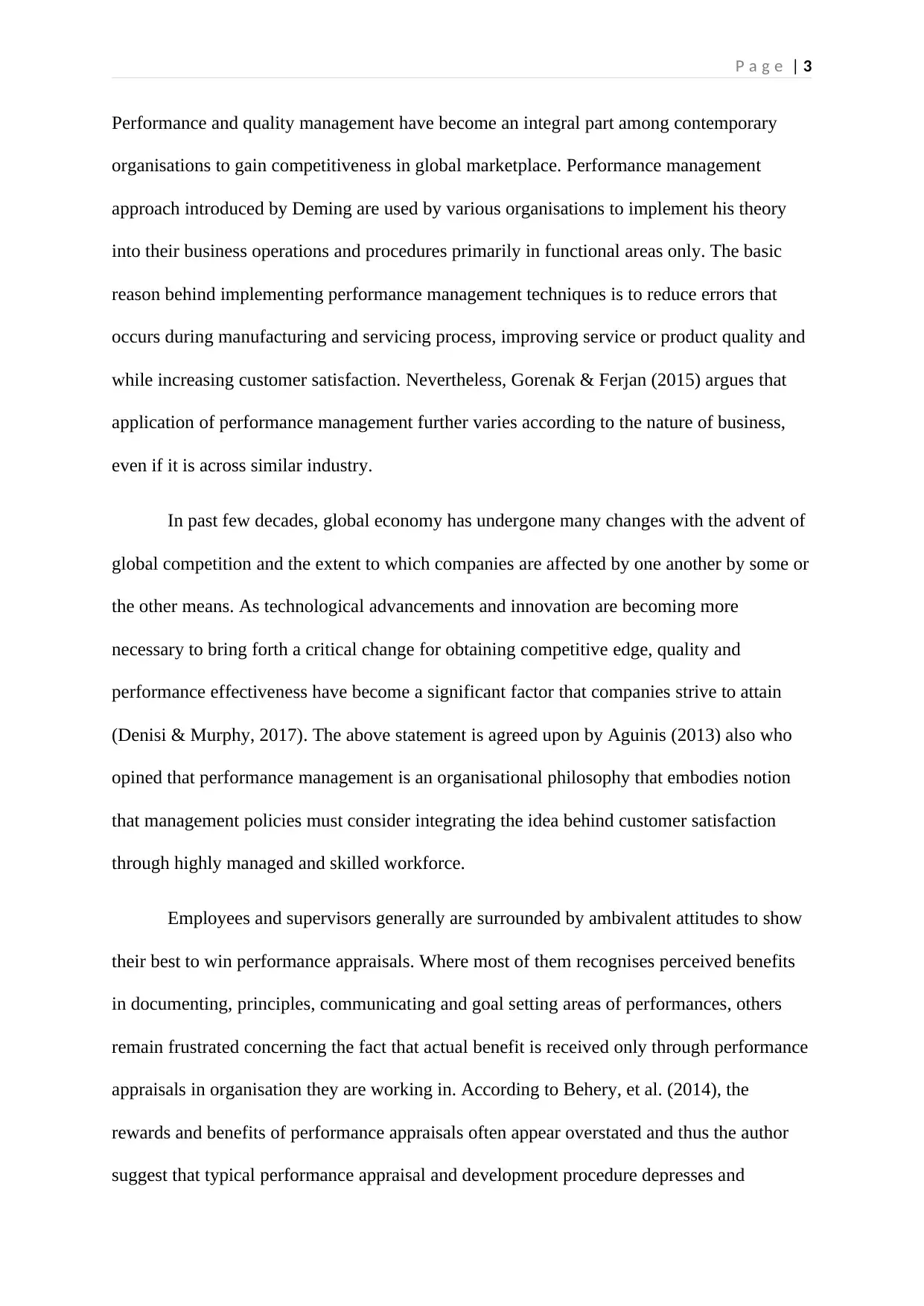
P a g e | 3
Performance and quality management have become an integral part among contemporary
organisations to gain competitiveness in global marketplace. Performance management
approach introduced by Deming are used by various organisations to implement his theory
into their business operations and procedures primarily in functional areas only. The basic
reason behind implementing performance management techniques is to reduce errors that
occurs during manufacturing and servicing process, improving service or product quality and
while increasing customer satisfaction. Nevertheless, Gorenak & Ferjan (2015) argues that
application of performance management further varies according to the nature of business,
even if it is across similar industry.
In past few decades, global economy has undergone many changes with the advent of
global competition and the extent to which companies are affected by one another by some or
the other means. As technological advancements and innovation are becoming more
necessary to bring forth a critical change for obtaining competitive edge, quality and
performance effectiveness have become a significant factor that companies strive to attain
(Denisi & Murphy, 2017). The above statement is agreed upon by Aguinis (2013) also who
opined that performance management is an organisational philosophy that embodies notion
that management policies must consider integrating the idea behind customer satisfaction
through highly managed and skilled workforce.
Employees and supervisors generally are surrounded by ambivalent attitudes to show
their best to win performance appraisals. Where most of them recognises perceived benefits
in documenting, principles, communicating and goal setting areas of performances, others
remain frustrated concerning the fact that actual benefit is received only through performance
appraisals in organisation they are working in. According to Behery, et al. (2014), the
rewards and benefits of performance appraisals often appear overstated and thus the author
suggest that typical performance appraisal and development procedure depresses and
Performance and quality management have become an integral part among contemporary
organisations to gain competitiveness in global marketplace. Performance management
approach introduced by Deming are used by various organisations to implement his theory
into their business operations and procedures primarily in functional areas only. The basic
reason behind implementing performance management techniques is to reduce errors that
occurs during manufacturing and servicing process, improving service or product quality and
while increasing customer satisfaction. Nevertheless, Gorenak & Ferjan (2015) argues that
application of performance management further varies according to the nature of business,
even if it is across similar industry.
In past few decades, global economy has undergone many changes with the advent of
global competition and the extent to which companies are affected by one another by some or
the other means. As technological advancements and innovation are becoming more
necessary to bring forth a critical change for obtaining competitive edge, quality and
performance effectiveness have become a significant factor that companies strive to attain
(Denisi & Murphy, 2017). The above statement is agreed upon by Aguinis (2013) also who
opined that performance management is an organisational philosophy that embodies notion
that management policies must consider integrating the idea behind customer satisfaction
through highly managed and skilled workforce.
Employees and supervisors generally are surrounded by ambivalent attitudes to show
their best to win performance appraisals. Where most of them recognises perceived benefits
in documenting, principles, communicating and goal setting areas of performances, others
remain frustrated concerning the fact that actual benefit is received only through performance
appraisals in organisation they are working in. According to Behery, et al. (2014), the
rewards and benefits of performance appraisals often appear overstated and thus the author
suggest that typical performance appraisal and development procedure depresses and
Paraphrase This Document
Need a fresh take? Get an instant paraphrase of this document with our AI Paraphraser
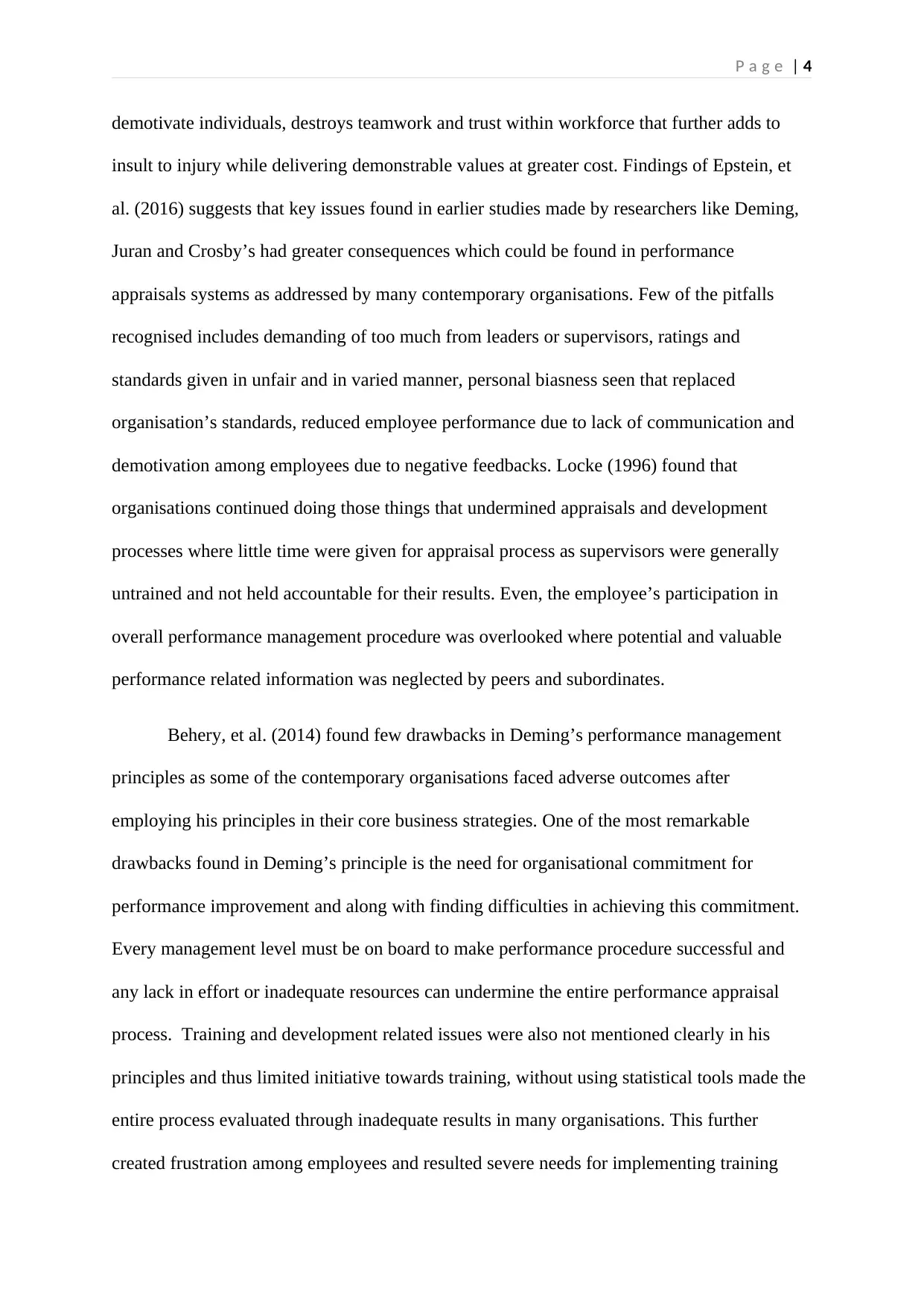
P a g e | 4
demotivate individuals, destroys teamwork and trust within workforce that further adds to
insult to injury while delivering demonstrable values at greater cost. Findings of Epstein, et
al. (2016) suggests that key issues found in earlier studies made by researchers like Deming,
Juran and Crosby’s had greater consequences which could be found in performance
appraisals systems as addressed by many contemporary organisations. Few of the pitfalls
recognised includes demanding of too much from leaders or supervisors, ratings and
standards given in unfair and in varied manner, personal biasness seen that replaced
organisation’s standards, reduced employee performance due to lack of communication and
demotivation among employees due to negative feedbacks. Locke (1996) found that
organisations continued doing those things that undermined appraisals and development
processes where little time were given for appraisal process as supervisors were generally
untrained and not held accountable for their results. Even, the employee’s participation in
overall performance management procedure was overlooked where potential and valuable
performance related information was neglected by peers and subordinates.
Behery, et al. (2014) found few drawbacks in Deming’s performance management
principles as some of the contemporary organisations faced adverse outcomes after
employing his principles in their core business strategies. One of the most remarkable
drawbacks found in Deming’s principle is the need for organisational commitment for
performance improvement and along with finding difficulties in achieving this commitment.
Every management level must be on board to make performance procedure successful and
any lack in effort or inadequate resources can undermine the entire performance appraisal
process. Training and development related issues were also not mentioned clearly in his
principles and thus limited initiative towards training, without using statistical tools made the
entire process evaluated through inadequate results in many organisations. This further
created frustration among employees and resulted severe needs for implementing training
demotivate individuals, destroys teamwork and trust within workforce that further adds to
insult to injury while delivering demonstrable values at greater cost. Findings of Epstein, et
al. (2016) suggests that key issues found in earlier studies made by researchers like Deming,
Juran and Crosby’s had greater consequences which could be found in performance
appraisals systems as addressed by many contemporary organisations. Few of the pitfalls
recognised includes demanding of too much from leaders or supervisors, ratings and
standards given in unfair and in varied manner, personal biasness seen that replaced
organisation’s standards, reduced employee performance due to lack of communication and
demotivation among employees due to negative feedbacks. Locke (1996) found that
organisations continued doing those things that undermined appraisals and development
processes where little time were given for appraisal process as supervisors were generally
untrained and not held accountable for their results. Even, the employee’s participation in
overall performance management procedure was overlooked where potential and valuable
performance related information was neglected by peers and subordinates.
Behery, et al. (2014) found few drawbacks in Deming’s performance management
principles as some of the contemporary organisations faced adverse outcomes after
employing his principles in their core business strategies. One of the most remarkable
drawbacks found in Deming’s principle is the need for organisational commitment for
performance improvement and along with finding difficulties in achieving this commitment.
Every management level must be on board to make performance procedure successful and
any lack in effort or inadequate resources can undermine the entire performance appraisal
process. Training and development related issues were also not mentioned clearly in his
principles and thus limited initiative towards training, without using statistical tools made the
entire process evaluated through inadequate results in many organisations. This further
created frustration among employees and resulted severe needs for implementing training
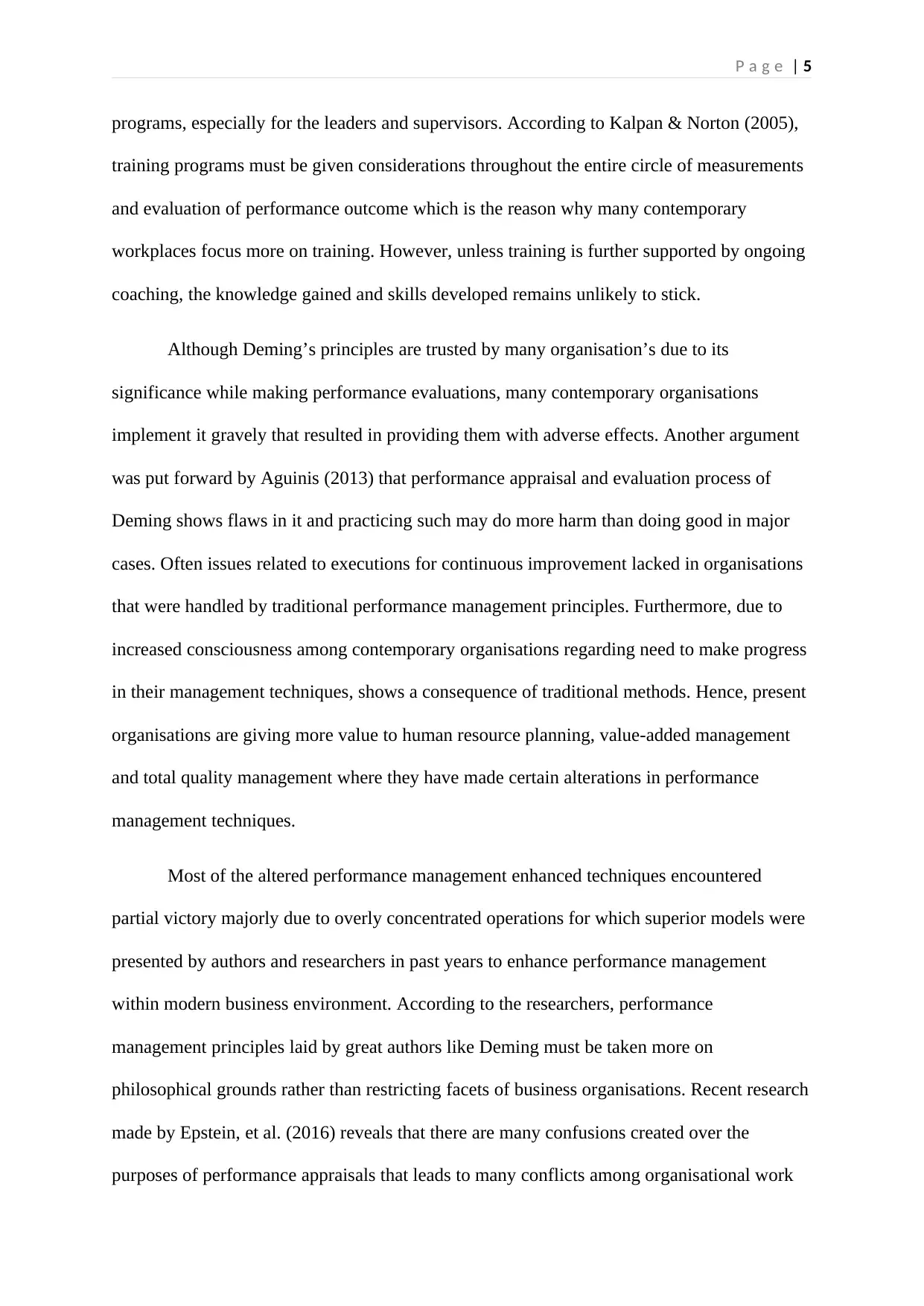
P a g e | 5
programs, especially for the leaders and supervisors. According to Kalpan & Norton (2005),
training programs must be given considerations throughout the entire circle of measurements
and evaluation of performance outcome which is the reason why many contemporary
workplaces focus more on training. However, unless training is further supported by ongoing
coaching, the knowledge gained and skills developed remains unlikely to stick.
Although Deming’s principles are trusted by many organisation’s due to its
significance while making performance evaluations, many contemporary organisations
implement it gravely that resulted in providing them with adverse effects. Another argument
was put forward by Aguinis (2013) that performance appraisal and evaluation process of
Deming shows flaws in it and practicing such may do more harm than doing good in major
cases. Often issues related to executions for continuous improvement lacked in organisations
that were handled by traditional performance management principles. Furthermore, due to
increased consciousness among contemporary organisations regarding need to make progress
in their management techniques, shows a consequence of traditional methods. Hence, present
organisations are giving more value to human resource planning, value-added management
and total quality management where they have made certain alterations in performance
management techniques.
Most of the altered performance management enhanced techniques encountered
partial victory majorly due to overly concentrated operations for which superior models were
presented by authors and researchers in past years to enhance performance management
within modern business environment. According to the researchers, performance
management principles laid by great authors like Deming must be taken more on
philosophical grounds rather than restricting facets of business organisations. Recent research
made by Epstein, et al. (2016) reveals that there are many confusions created over the
purposes of performance appraisals that leads to many conflicts among organisational work
programs, especially for the leaders and supervisors. According to Kalpan & Norton (2005),
training programs must be given considerations throughout the entire circle of measurements
and evaluation of performance outcome which is the reason why many contemporary
workplaces focus more on training. However, unless training is further supported by ongoing
coaching, the knowledge gained and skills developed remains unlikely to stick.
Although Deming’s principles are trusted by many organisation’s due to its
significance while making performance evaluations, many contemporary organisations
implement it gravely that resulted in providing them with adverse effects. Another argument
was put forward by Aguinis (2013) that performance appraisal and evaluation process of
Deming shows flaws in it and practicing such may do more harm than doing good in major
cases. Often issues related to executions for continuous improvement lacked in organisations
that were handled by traditional performance management principles. Furthermore, due to
increased consciousness among contemporary organisations regarding need to make progress
in their management techniques, shows a consequence of traditional methods. Hence, present
organisations are giving more value to human resource planning, value-added management
and total quality management where they have made certain alterations in performance
management techniques.
Most of the altered performance management enhanced techniques encountered
partial victory majorly due to overly concentrated operations for which superior models were
presented by authors and researchers in past years to enhance performance management
within modern business environment. According to the researchers, performance
management principles laid by great authors like Deming must be taken more on
philosophical grounds rather than restricting facets of business organisations. Recent research
made by Epstein, et al. (2016) reveals that there are many confusions created over the
purposes of performance appraisals that leads to many conflicts among organisational work
⊘ This is a preview!⊘
Do you want full access?
Subscribe today to unlock all pages.

Trusted by 1+ million students worldwide
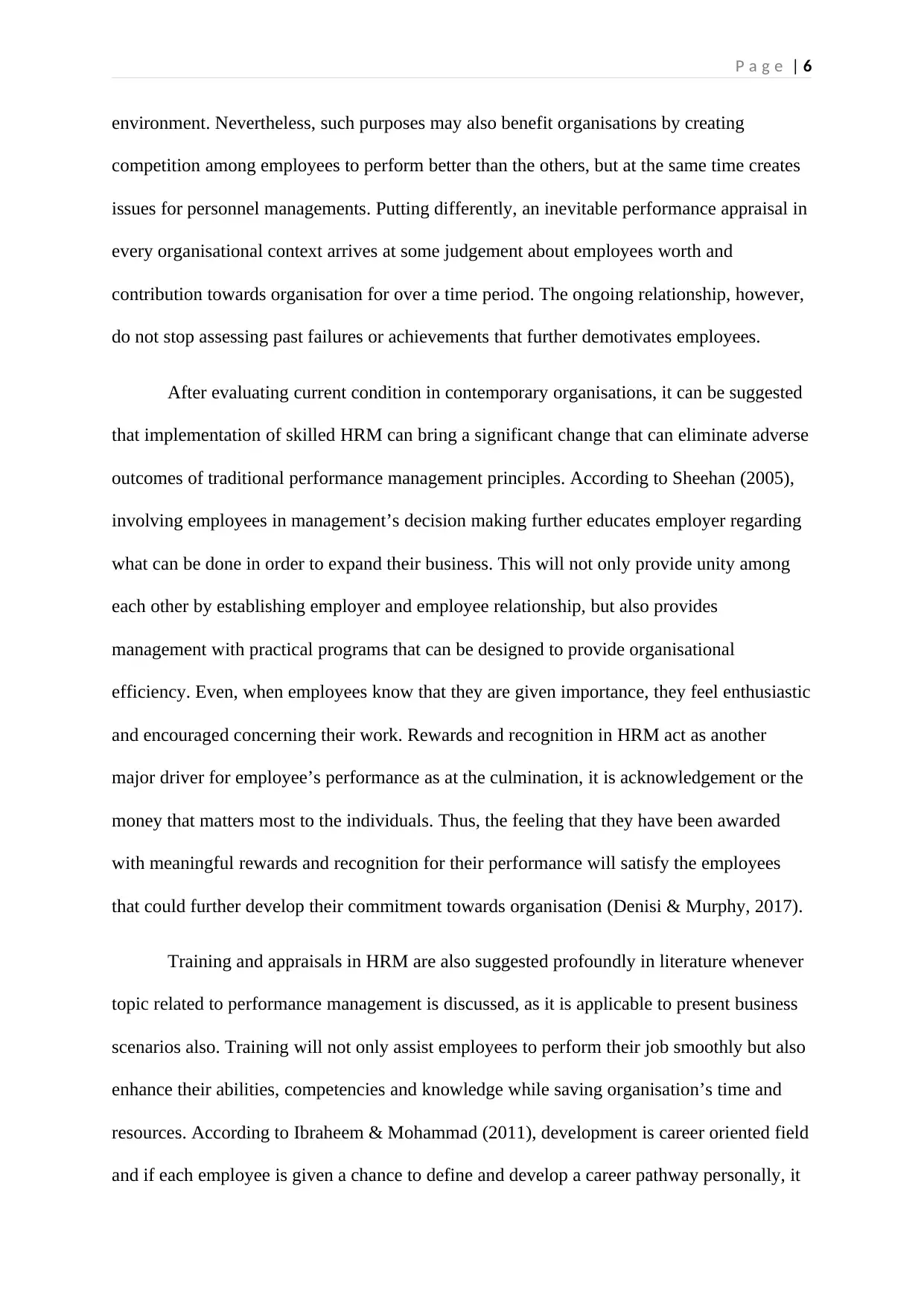
P a g e | 6
environment. Nevertheless, such purposes may also benefit organisations by creating
competition among employees to perform better than the others, but at the same time creates
issues for personnel managements. Putting differently, an inevitable performance appraisal in
every organisational context arrives at some judgement about employees worth and
contribution towards organisation for over a time period. The ongoing relationship, however,
do not stop assessing past failures or achievements that further demotivates employees.
After evaluating current condition in contemporary organisations, it can be suggested
that implementation of skilled HRM can bring a significant change that can eliminate adverse
outcomes of traditional performance management principles. According to Sheehan (2005),
involving employees in management’s decision making further educates employer regarding
what can be done in order to expand their business. This will not only provide unity among
each other by establishing employer and employee relationship, but also provides
management with practical programs that can be designed to provide organisational
efficiency. Even, when employees know that they are given importance, they feel enthusiastic
and encouraged concerning their work. Rewards and recognition in HRM act as another
major driver for employee’s performance as at the culmination, it is acknowledgement or the
money that matters most to the individuals. Thus, the feeling that they have been awarded
with meaningful rewards and recognition for their performance will satisfy the employees
that could further develop their commitment towards organisation (Denisi & Murphy, 2017).
Training and appraisals in HRM are also suggested profoundly in literature whenever
topic related to performance management is discussed, as it is applicable to present business
scenarios also. Training will not only assist employees to perform their job smoothly but also
enhance their abilities, competencies and knowledge while saving organisation’s time and
resources. According to Ibraheem & Mohammad (2011), development is career oriented field
and if each employee is given a chance to define and develop a career pathway personally, it
environment. Nevertheless, such purposes may also benefit organisations by creating
competition among employees to perform better than the others, but at the same time creates
issues for personnel managements. Putting differently, an inevitable performance appraisal in
every organisational context arrives at some judgement about employees worth and
contribution towards organisation for over a time period. The ongoing relationship, however,
do not stop assessing past failures or achievements that further demotivates employees.
After evaluating current condition in contemporary organisations, it can be suggested
that implementation of skilled HRM can bring a significant change that can eliminate adverse
outcomes of traditional performance management principles. According to Sheehan (2005),
involving employees in management’s decision making further educates employer regarding
what can be done in order to expand their business. This will not only provide unity among
each other by establishing employer and employee relationship, but also provides
management with practical programs that can be designed to provide organisational
efficiency. Even, when employees know that they are given importance, they feel enthusiastic
and encouraged concerning their work. Rewards and recognition in HRM act as another
major driver for employee’s performance as at the culmination, it is acknowledgement or the
money that matters most to the individuals. Thus, the feeling that they have been awarded
with meaningful rewards and recognition for their performance will satisfy the employees
that could further develop their commitment towards organisation (Denisi & Murphy, 2017).
Training and appraisals in HRM are also suggested profoundly in literature whenever
topic related to performance management is discussed, as it is applicable to present business
scenarios also. Training will not only assist employees to perform their job smoothly but also
enhance their abilities, competencies and knowledge while saving organisation’s time and
resources. According to Ibraheem & Mohammad (2011), development is career oriented field
and if each employee is given a chance to define and develop a career pathway personally, it
Paraphrase This Document
Need a fresh take? Get an instant paraphrase of this document with our AI Paraphraser
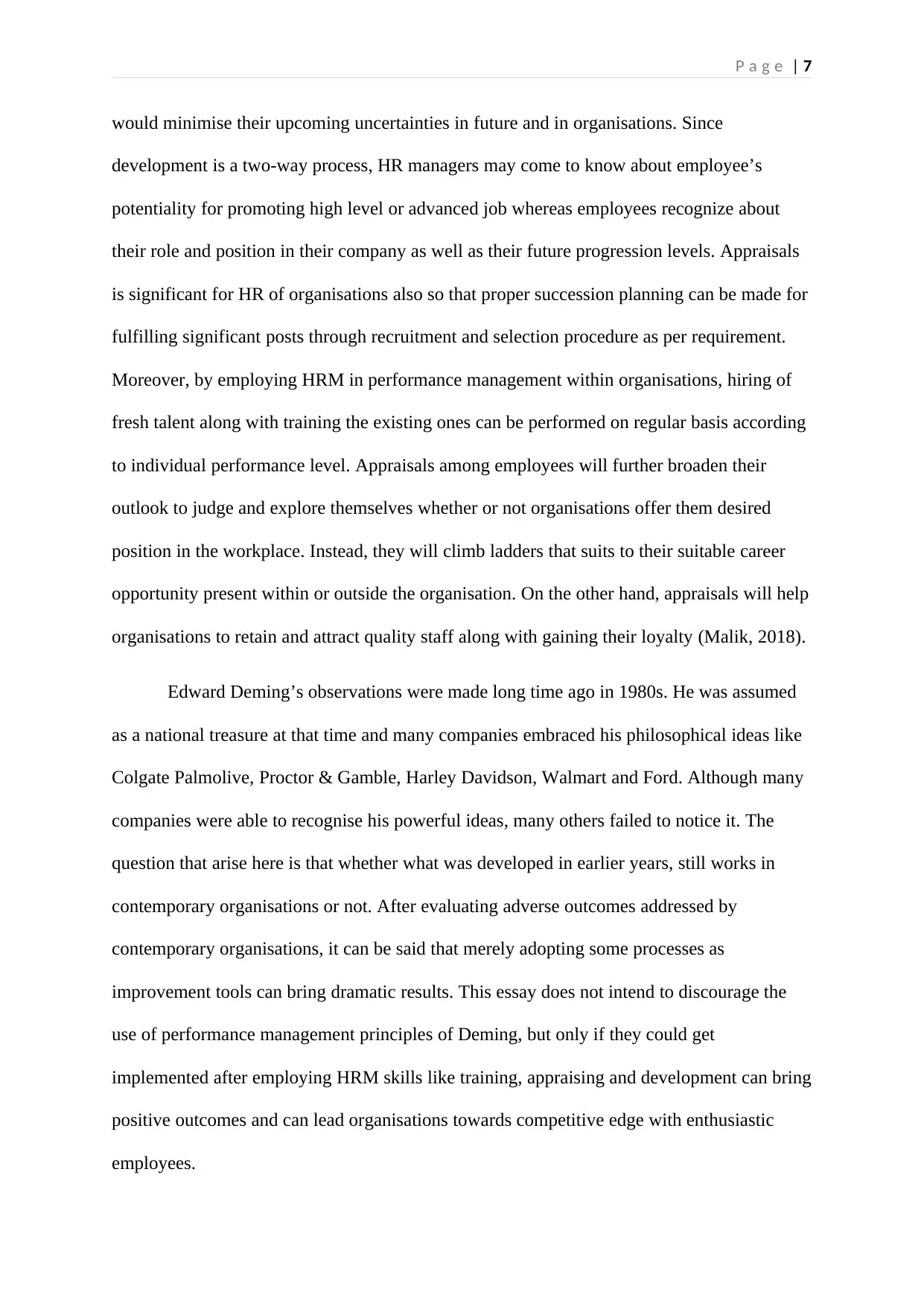
P a g e | 7
would minimise their upcoming uncertainties in future and in organisations. Since
development is a two-way process, HR managers may come to know about employee’s
potentiality for promoting high level or advanced job whereas employees recognize about
their role and position in their company as well as their future progression levels. Appraisals
is significant for HR of organisations also so that proper succession planning can be made for
fulfilling significant posts through recruitment and selection procedure as per requirement.
Moreover, by employing HRM in performance management within organisations, hiring of
fresh talent along with training the existing ones can be performed on regular basis according
to individual performance level. Appraisals among employees will further broaden their
outlook to judge and explore themselves whether or not organisations offer them desired
position in the workplace. Instead, they will climb ladders that suits to their suitable career
opportunity present within or outside the organisation. On the other hand, appraisals will help
organisations to retain and attract quality staff along with gaining their loyalty (Malik, 2018).
Edward Deming’s observations were made long time ago in 1980s. He was assumed
as a national treasure at that time and many companies embraced his philosophical ideas like
Colgate Palmolive, Proctor & Gamble, Harley Davidson, Walmart and Ford. Although many
companies were able to recognise his powerful ideas, many others failed to notice it. The
question that arise here is that whether what was developed in earlier years, still works in
contemporary organisations or not. After evaluating adverse outcomes addressed by
contemporary organisations, it can be said that merely adopting some processes as
improvement tools can bring dramatic results. This essay does not intend to discourage the
use of performance management principles of Deming, but only if they could get
implemented after employing HRM skills like training, appraising and development can bring
positive outcomes and can lead organisations towards competitive edge with enthusiastic
employees.
would minimise their upcoming uncertainties in future and in organisations. Since
development is a two-way process, HR managers may come to know about employee’s
potentiality for promoting high level or advanced job whereas employees recognize about
their role and position in their company as well as their future progression levels. Appraisals
is significant for HR of organisations also so that proper succession planning can be made for
fulfilling significant posts through recruitment and selection procedure as per requirement.
Moreover, by employing HRM in performance management within organisations, hiring of
fresh talent along with training the existing ones can be performed on regular basis according
to individual performance level. Appraisals among employees will further broaden their
outlook to judge and explore themselves whether or not organisations offer them desired
position in the workplace. Instead, they will climb ladders that suits to their suitable career
opportunity present within or outside the organisation. On the other hand, appraisals will help
organisations to retain and attract quality staff along with gaining their loyalty (Malik, 2018).
Edward Deming’s observations were made long time ago in 1980s. He was assumed
as a national treasure at that time and many companies embraced his philosophical ideas like
Colgate Palmolive, Proctor & Gamble, Harley Davidson, Walmart and Ford. Although many
companies were able to recognise his powerful ideas, many others failed to notice it. The
question that arise here is that whether what was developed in earlier years, still works in
contemporary organisations or not. After evaluating adverse outcomes addressed by
contemporary organisations, it can be said that merely adopting some processes as
improvement tools can bring dramatic results. This essay does not intend to discourage the
use of performance management principles of Deming, but only if they could get
implemented after employing HRM skills like training, appraising and development can bring
positive outcomes and can lead organisations towards competitive edge with enthusiastic
employees.

P a g e | 8
References
References
⊘ This is a preview!⊘
Do you want full access?
Subscribe today to unlock all pages.

Trusted by 1+ million students worldwide
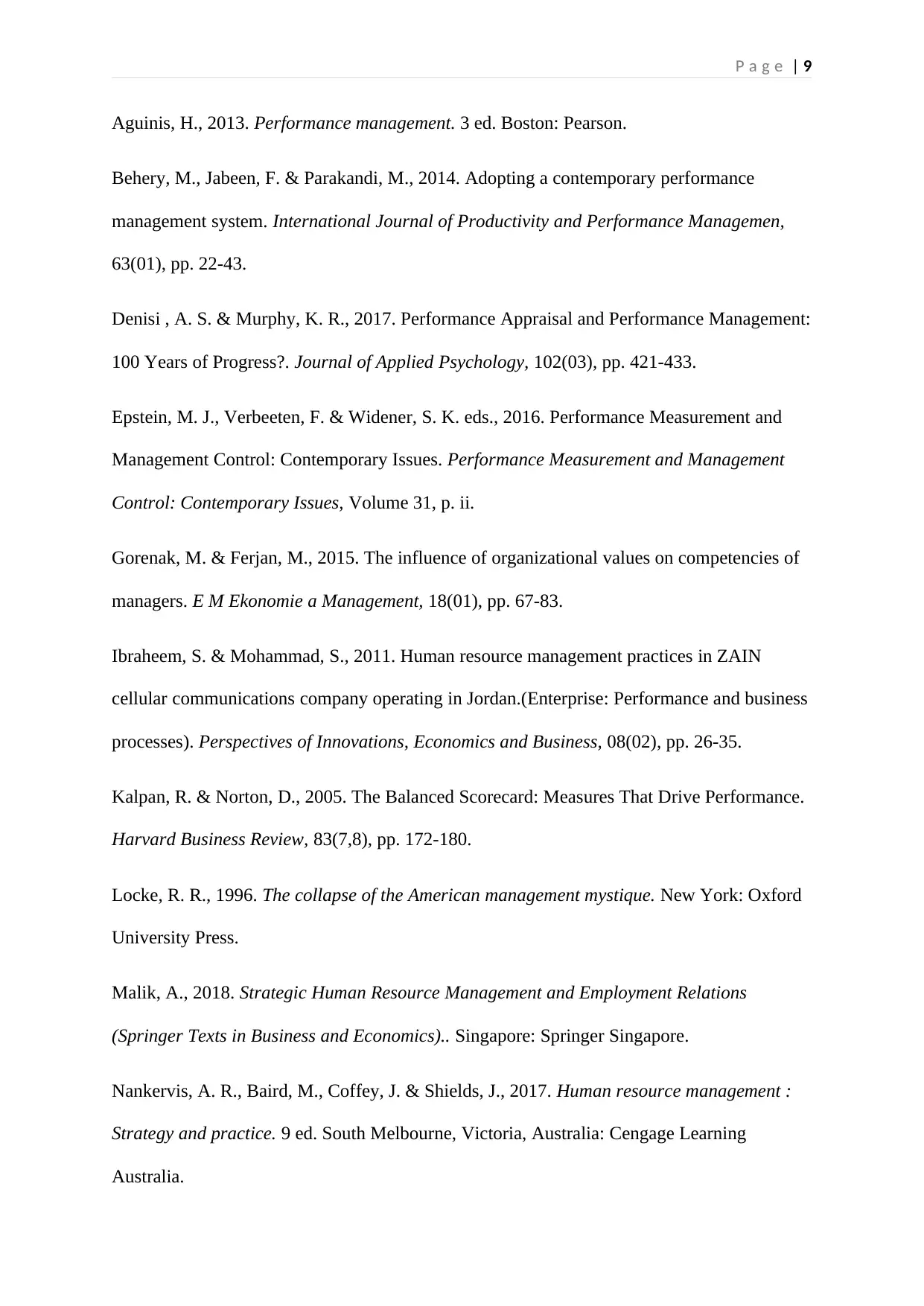
P a g e | 9
Aguinis, H., 2013. Performance management. 3 ed. Boston: Pearson.
Behery, M., Jabeen, F. & Parakandi, M., 2014. Adopting a contemporary performance
management system. International Journal of Productivity and Performance Managemen,
63(01), pp. 22-43.
Denisi , A. S. & Murphy, K. R., 2017. Performance Appraisal and Performance Management:
100 Years of Progress?. Journal of Applied Psychology, 102(03), pp. 421-433.
Epstein, M. J., Verbeeten, F. & Widener, S. K. eds., 2016. Performance Measurement and
Management Control: Contemporary Issues. Performance Measurement and Management
Control: Contemporary Issues, Volume 31, p. ii.
Gorenak, M. & Ferjan, M., 2015. The influence of organizational values on competencies of
managers. E M Ekonomie a Management, 18(01), pp. 67-83.
Ibraheem, S. & Mohammad, S., 2011. Human resource management practices in ZAIN
cellular communications company operating in Jordan.(Enterprise: Performance and business
processes). Perspectives of Innovations, Economics and Business, 08(02), pp. 26-35.
Kalpan, R. & Norton, D., 2005. The Balanced Scorecard: Measures That Drive Performance.
Harvard Business Review, 83(7,8), pp. 172-180.
Locke, R. R., 1996. The collapse of the American management mystique. New York: Oxford
University Press.
Malik, A., 2018. Strategic Human Resource Management and Employment Relations
(Springer Texts in Business and Economics).. Singapore: Springer Singapore.
Nankervis, A. R., Baird, M., Coffey, J. & Shields, J., 2017. Human resource management :
Strategy and practice. 9 ed. South Melbourne, Victoria, Australia: Cengage Learning
Australia.
Aguinis, H., 2013. Performance management. 3 ed. Boston: Pearson.
Behery, M., Jabeen, F. & Parakandi, M., 2014. Adopting a contemporary performance
management system. International Journal of Productivity and Performance Managemen,
63(01), pp. 22-43.
Denisi , A. S. & Murphy, K. R., 2017. Performance Appraisal and Performance Management:
100 Years of Progress?. Journal of Applied Psychology, 102(03), pp. 421-433.
Epstein, M. J., Verbeeten, F. & Widener, S. K. eds., 2016. Performance Measurement and
Management Control: Contemporary Issues. Performance Measurement and Management
Control: Contemporary Issues, Volume 31, p. ii.
Gorenak, M. & Ferjan, M., 2015. The influence of organizational values on competencies of
managers. E M Ekonomie a Management, 18(01), pp. 67-83.
Ibraheem, S. & Mohammad, S., 2011. Human resource management practices in ZAIN
cellular communications company operating in Jordan.(Enterprise: Performance and business
processes). Perspectives of Innovations, Economics and Business, 08(02), pp. 26-35.
Kalpan, R. & Norton, D., 2005. The Balanced Scorecard: Measures That Drive Performance.
Harvard Business Review, 83(7,8), pp. 172-180.
Locke, R. R., 1996. The collapse of the American management mystique. New York: Oxford
University Press.
Malik, A., 2018. Strategic Human Resource Management and Employment Relations
(Springer Texts in Business and Economics).. Singapore: Springer Singapore.
Nankervis, A. R., Baird, M., Coffey, J. & Shields, J., 2017. Human resource management :
Strategy and practice. 9 ed. South Melbourne, Victoria, Australia: Cengage Learning
Australia.
Paraphrase This Document
Need a fresh take? Get an instant paraphrase of this document with our AI Paraphraser
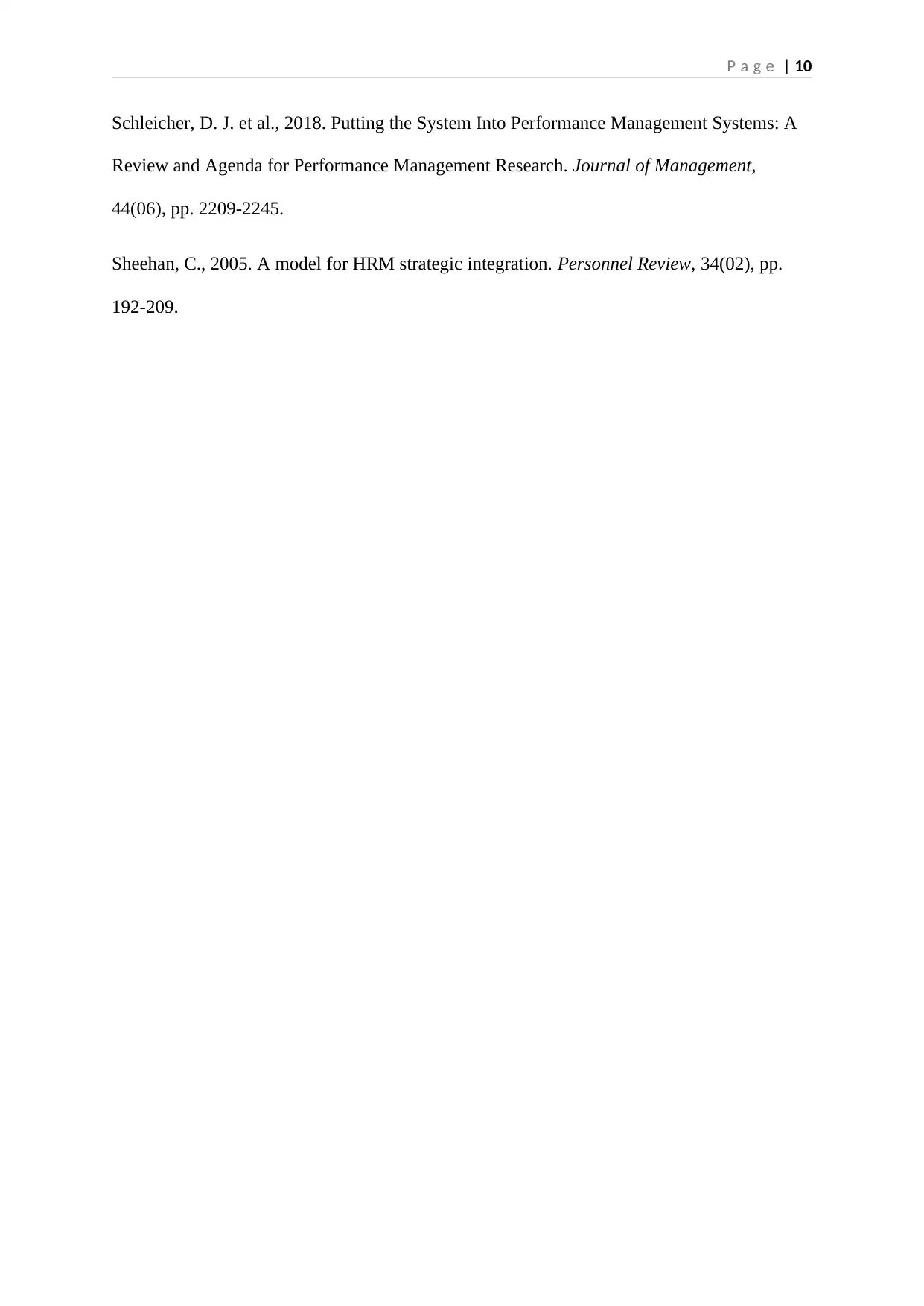
P a g e | 10
Schleicher, D. J. et al., 2018. Putting the System Into Performance Management Systems: A
Review and Agenda for Performance Management Research. Journal of Management,
44(06), pp. 2209-2245.
Sheehan, C., 2005. A model for HRM strategic integration. Personnel Review, 34(02), pp.
192-209.
Schleicher, D. J. et al., 2018. Putting the System Into Performance Management Systems: A
Review and Agenda for Performance Management Research. Journal of Management,
44(06), pp. 2209-2245.
Sheehan, C., 2005. A model for HRM strategic integration. Personnel Review, 34(02), pp.
192-209.
1 out of 11
Related Documents
Your All-in-One AI-Powered Toolkit for Academic Success.
+13062052269
info@desklib.com
Available 24*7 on WhatsApp / Email
![[object Object]](/_next/static/media/star-bottom.7253800d.svg)
Unlock your academic potential
Copyright © 2020–2025 A2Z Services. All Rights Reserved. Developed and managed by ZUCOL.




